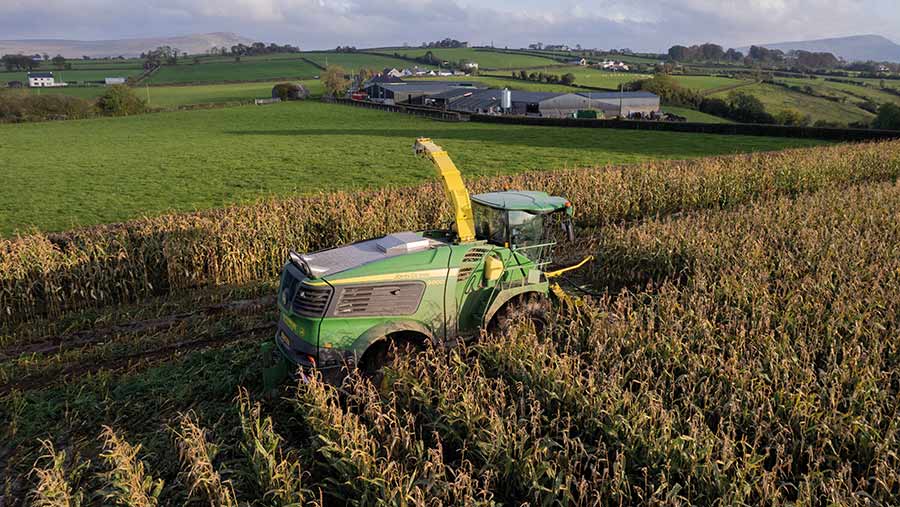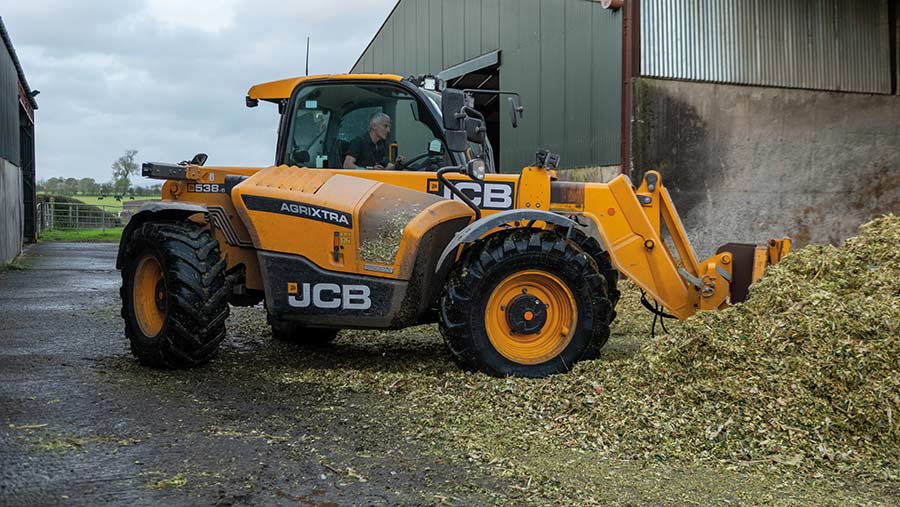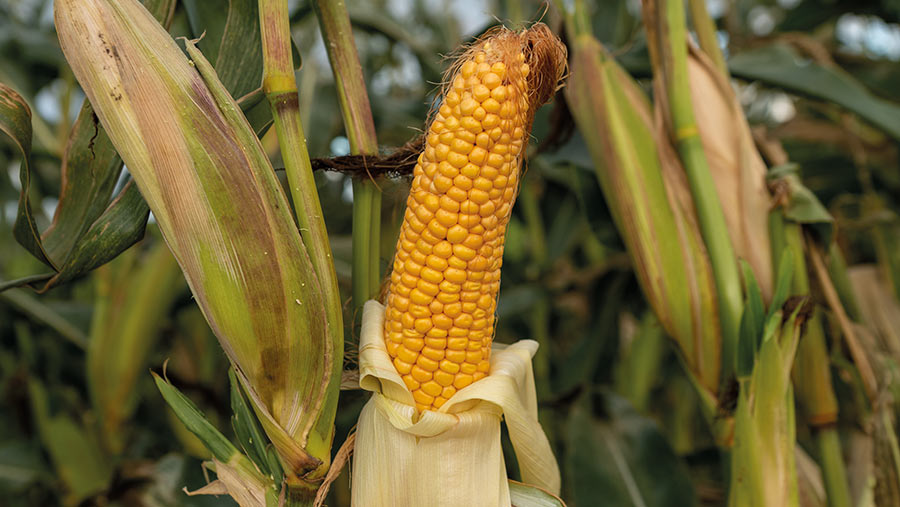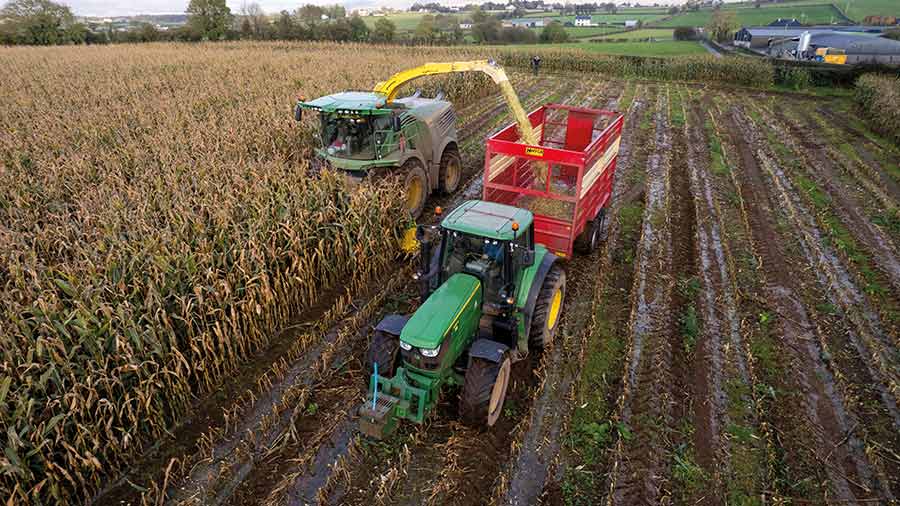How maize is driving dry matter intake in NI dairy herd
 © Andrew Robinson
© Andrew Robinson Feed intakes are up, fertility has improved and milk yield is on the rise after a successful first winter feeding maize at Purcell Farms, County Londonderry.
Mixed farmer James Purcell farms in Limavady in partnership with his father, Ivor, uncle, William, and cousin, John.
See also: 6 top maize growing tips to help livestock producers
He had always wanted to try growing maize for their dairy cows since seeing it grown and fed when he worked in New Zealand.
However, he was worried it would not be possible because of ground type and the cost of establishment.
Farm facts: Purcell Farms
- 312ha (770 acres) owned and rented
- Dairy, beef, sheep and arable enterprises
- Dairy cows run as two groups – one milked in the parlour and one by robots
- All-year-round calving herd, supplying Lakeland Dairies
- 10,800 litres predicted 305-day milk yield of robot group
- 4.23% butterfat and 3.3% protein content of milk
In the end, they decided they would never know unless they tried it. They drilled 4.5ha (11 acres) last spring and plan to drill an additional 5.3ha (13 acres) this year.
The 220-head predominantly Holstein herd is split into two management groups, with one grass-based herd milked through a parlour and another group of 65 cows fully housed in a robotic unit.
Keen to increase intakes and yield from forage, Mr Purcell decided to trial the maize with the latter group.
“It’s a good alternative forage, it complements Northern Irish grass silages quite well.
“We’ve found it drives dry matter (DM) intake and that increases milk production and milk quality. Increasing the forage gives us the potential to reduce purchased compound too,” he says.
He has seen intakes lift by 4kg a head a day and estimates that daily milk yield has increased by 1.5 litres a head.
Milk from forage has gone from an average of 1,400 litres across the whole herd to 2,570 litres for the group fed maize.
“Cows have got a real good shine on their coats, visibility of heats has drastically improved and butterfat and protein are on the increase – everything seems to be ticking along a lot better than it was before the maize,” he adds.

© James Purcell
The numbers
1,300mm: Average annual rainfall across farm
8-10 months: Time period of feeding total mixed ration including maize
1.5 litres: Increase in milk yield a head a day since introducing maize
Nutritional management
Feeding began on 11 November 2022. The ration (see box) was carefully balanced with the help of the farm’s nutritionist and informed by analysis of the maize and second-cut grass silage included in it.
“We try to balance home-grown forage to maximise efficiency,” explains Mr Purcell.
However, he has had to reduce maize meal and introduce more soya into the ration to avoid underfeeding protein and compromising on production.
“One option would be purchasing locally grown proteins or even trying to grow our own, such as beans and lupins, to partially offset our soya usage.”
Slight adjustment was also needed to the concentrate fed at milking time.
Before maize was introduced into the ration, fresh cows would get a 16% protein nut and cows further into lactation would get an 18% nut.
However, the 18% nut needed switching to a 20% protein concentrate to maintain milk yield.
Total mixed ration at Purcell Farms
- 8kg maize silage: 39% dry matter (DM), 11.8MJ of metabolisable energy (ME)/kg DM, 35.1% DM starch with a digestibility (D)-value of 74.9
- 38kg grass silage: 25.8% DM, 15.2% protein, 11.4MJ ME/kg DM with a D-value of 71.2
- 1.5kg maize meal
- 2.5kg soya bean meal
- 1.5kg soya hulls

© James Purcell
Crop management
The maize crop was drilled under film on land that was previously down to barley in April last year.
The ground was subsoiled, spread with farmyard manure, ploughed and power-harrowed twice. The seed-bed was then fertilised before the seed was drilled with a Samco maize drill.
“Once it was planted, we didn’t go in that gate again with a machine until it was harvested,” Mr Purcell says.
With an arable enterprise, they have the machinery to do all groundwork, but used a contractor to drill and harvest the crop.
“There is no reason we can’t keep cropping the same area if we can keep compaction levels low – so I’m told anyway.
“My plan is to grow in those fields for as long as possible. Down the line, we will probably go in with winter wheat straight after harvest because they say that does well after maize.
“There are no big areas of maize here. In a densely populated cow area, I think last year there were just three of us trialling it for a six-eight mile radius.”
They planted a mix of two varieties from Pioneer, P7326 and P7524: one for yield and one for quality, as advised by seed supplier Shine’s Agri.
The crop was harvested on 20 October. Fortunately, the ground was hard enough to allow that, but Mr Purcell hopes to plant an earlier-ripening variety this year.
This is because in a normal weather year, he thinks even 10 days could make a lot of difference.
“We reckon the better field yielded about 18t/acre [44t/ha] and the lower field was around 15-16t/acre [37-40t/ha].
“We’re happy with that, given our situation and rainfall. The dry weather actually helped us – it takes a lot for us to dry out here,” he says.
The farm is mainly a mix of clay loam and darker clay soils. “We do have some sandy loams but the fields are either not south facing or not accessible, so aren’t suitable for maize,” he adds.
The crop was consolidated in an indoor clamp and an additive used to prevent spoilage. The walls and top were sealed with a cling film before using black plastic and rubber mats on top.
Future plans
This year, the hope is that by doubling the crop area, Mr Purcell will be able to increase the amount of maize fed to 15kg a head a day.
With soil erosion in mind, he is considering how he could use a nitrogen-fixing cover crop during the winter.
He says it will be trial and error for a few years, but is hopeful that continued progress in the seed breeding sector might result in more varieties suitable for his farm.
“Ultimately, we aim to feed cows well to increase longevity and decrease cull rate, which I suppose helps to tick the carbon boxes too,” he says.
“I’m glad I have used the advice we’ve had, even if they been selling something, because it’s easy to keep doing what you’re doing, but you have to take a risk every now and again.”

© James Purcell
